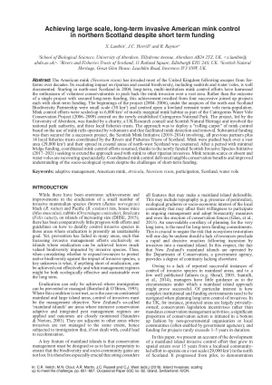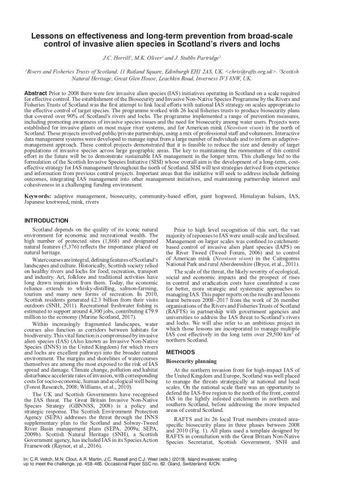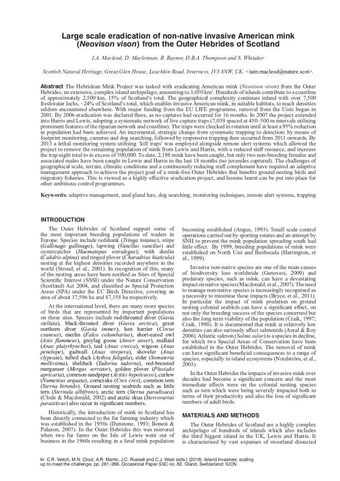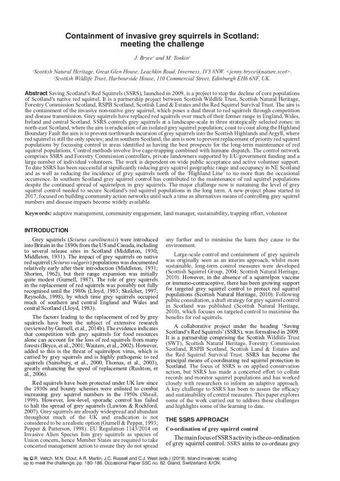Achieving large scale, long-term invasive American mink control in northern Scotland despite short term funding
- Description:
- The American mink (Neovison vison) has invaded most of the United Kingdom following escapes from furfarms over decades. Its escalating impact on riparian and coastal biodiversity, including seabirds and water voles, is well documented. Starting in north-east Scotland in 2004, long-term, multi-institution mink control efforts have harnessed the enthusiasm of volunteer conservationists to push back the mink invasion over a vast area. Rather than the outcome of a single project with secured long-term funding, this achievement resulted from four successive joined up projects each with short-term funding. The beginnings of the project (20042006), under the auspices of the north-east Scotland Biodiversity Partnership were small scale (30 km2) and centred upon a lowland remnant water vole meta-population. Mink control efforts were scaled-up to 6,000 km2 of mostly marginal mink habitat as part of the Cairngorms Water Vole Conservation Project (20062009) centred on the newly established Cairngorms National Park. The project, led by the University of Aberdeen, was funded by a charity, a UK Research council and Scottish Natural Heritage and involved the national park authority, and three local fisheries trusts. The approach was to deploy a rolling carpet of mink control based on the use of mink rafts operated by volunteers and that facilitated mink detection and removal. Substantial funding was then secured for a successor project, the Scottish Mink Initiative (20102014) involving, all previous partners plus 14 local fisheries trusts coordinated by the Rivers and Fisheries Trusts of Scotland. Mink were pushed back over a vast area (29,000 km2) and their spread in coastal areas of north-west Scotland was countered. After a period with minimal bridge funding, coordinated mink control efforts resumed, thanks to the newly funded Scottish Invasive Species Initiative (20172021) seeking to extend the approach used with mink to other riparian invasives. Mink remain scarce or absent and water voles are recovering spectacularly. Coordinated mink control delivered tangible conservation benefits and improved understanding of the socio-ecological system despite the challenges of short-term funding.
- Display date:
- 2019
- Collections:
- Secretariat of the Pacific Regional Environment Programme (SPREP)
- Publisher:
- International Union for Nature Conservation (IUCN)
- Content partner:
- Secretariat of the Pacific Regional Environment Programme (SPREP)
- Availability:
- Not specified
-
Copyright status: All rights reservedFind out more about what you are able to do with this itemThis item is all rights reserved, with means you'll have to get permission from Secretariat of the Pacific Regional Environment Programme (SPREP) before using it. For more information, please see our use and reuse page.What can I do with this item?Non-infringing useNZ copyright law does not prevent every use of a copyright work, and this item may be hosted by an international institute or organisation. You should consider what you can and cannot do with a copyright work.No sharingYou may not copy and/or share this item with others without further permission. This includes posting it on your blog, using it in a presentation, or any other public use.No modifyingYou are not allowed to adapt or remix this item into any other works.No commercial useYou may not use this item commercially.
Related items
Welcome and warm Pasifik greetings
The information on this site has been gathered from our content partners.
The names, terms, and labels that we present on the site may contain images or voices of deceased persons and may also reflect the bias, norms, and perspective of the period of time in which they were created. We accept that these may not be appropriate today.
If you have any concerns or questions about an item, please contact us.



